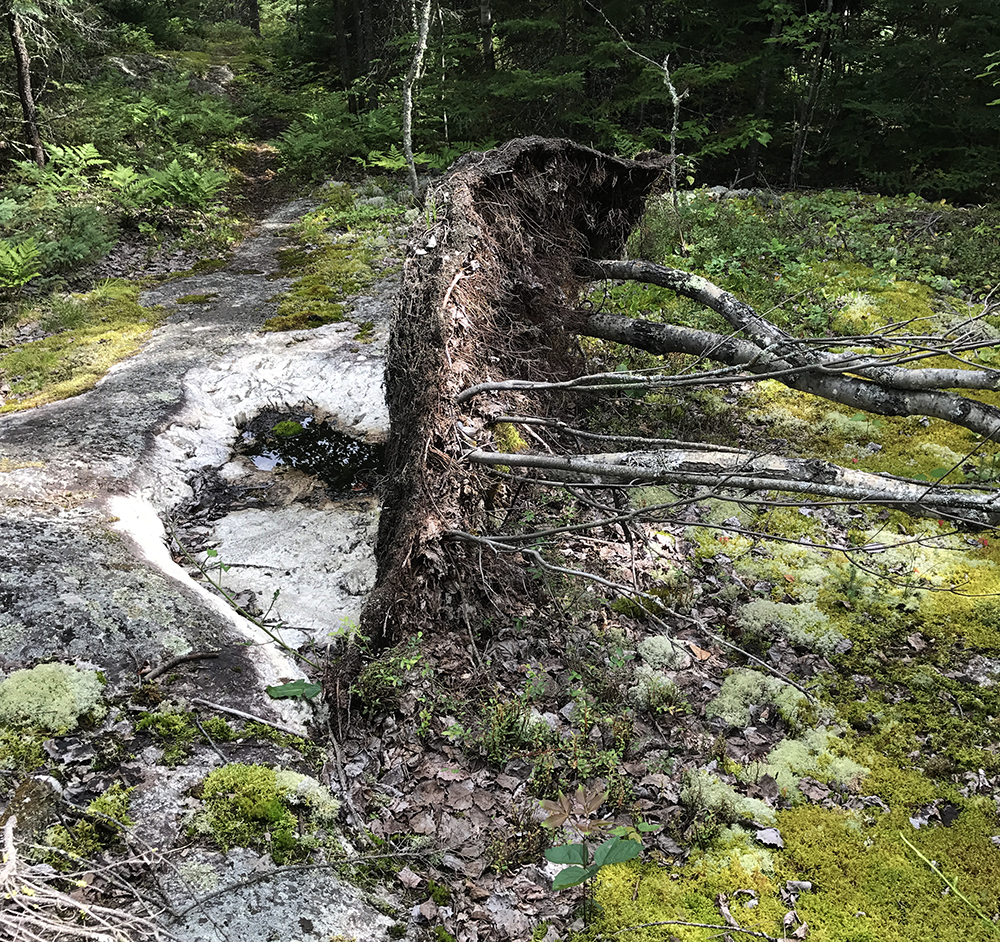Our brief study of the geology of Voyageurs National Park reveals that this land is built upon the hollowed out remains of an ancient volcanic mountain range that scientists estimate reached heights of more than 35,000 feet, taller than any mountain on Earth today.

Guide to Voyageurs
Ancient Volcanic Mountains
This is a unique landscape created by violent earthquakes, volcanic activity which produced massive mountains, and more recently, periods of glaciation, the last of which ended some 10,000-12,000 years ago.
But let’s begin with the early days, some 3 billion years ago…
The Canadian Shield
The rocks observed in Voyageurs represent the southern terminus of a massive chunk of volcanic bedrock that geologists call the Canadian Shield. This large area of exposed basement rock contains some of the oldest Precambrian rocks on earth, in fact, these rocks form the very core of the North American continent. The Shield is massive, stretching from the Arctic Ocean to the Great Lakes, and covering more than half of Canada, and more than half of Greenland.

The metamorphic and igneous rocks found here are the products of extensive volcanic activity, combined with the actions of ancient subduction zones that were formed by moving lithographic plates during the formation of the North American continent, some 2.5 billion years ago. This time period and the effects of these circumstances gave rise to the Algoman Orogeny, the earliest datable mountain building episode in North America.
Scientists believe that the earliest mountains of the Canadian Shield were taller than any on Earth today, standing in excess of 35,000 feet. By comparison, Mount Everest, currently the world’s tallest mountain stands at 29,029′. Over the billions of years since the Shield’s formation, the mountains have eroded to the point that a park visitor in Voyageurs today may consider you to have lost your mind if you told them the elevation of the area’s ancient mountains.
Glaciers
Beginning some 190,000 years ago, massive ice sheets of the Pleistocene epoch covered the northern reaches of the continent. Scientists believe there were at least four periods of glaciation that sculpted the landscape we witness today in Voyageurs. These rivers of ice slowly bulldozed the terrain with little tolerance for a single jagged hill.
The steady movement of large sheets of ice that were miles thick, carved lakes and rounded cliffs, slowly forming the spectacular waterways and lakes that would one day usher the Voyageurs boatmen into the unknown west in search of their prey.
Many of the glaciers that covered the area were up to a mile thick, and the excessive amount of weight pressed upon the earth forced the compression of the earth’s crust. Upon the retreat of the Wisconsin Glaciation some 11,000 years ago, the earth’s subterranean forces began to rebound. Today, the landscape of Voyageurs is rising at the rate of about a foot per century.
Forests
Slowly, as the ice retreated, plants began the struggle to adapt to the newly uncovered environment. Lichen attached to the rocks, and small plants began to attach to any sliver of soil that was available. As the years passed, a thin layer of soil formed, which lended support to a growing forest.
Today, stands of trees grow tightly together, with ample areas of exposed lichen-rich rock separating one group from another. Countless toppled trees lie leveled throughout the park; their nearly flat roots now reach vertically, revealing shallow bowls where small soil accumulations formerly invited rooting for a young sapling.

Such scenes make evident the thin, youthful soil layer, and showcase the difficult task growing trees face when attempting to make roots in Voyageurs’ thin soils which cover impenetrable stone below. Of course, a tree’s fallen remains provide soil for future growth, and thus, the natural cycle continues with a small amount of additional life-supporting soil.
Despite the thin residual soils here, the land is heavily forested, and this latitude marks the transition point between the southern reaches of boreal forests, and the northern limits of deciduous hardwood forests. Majestic groves of white and red pines stand among small communities of aspen, birch, fir, red maple and spruce. Upon further inland exploration, hungry hikers can find feasts-a-plenty on bushes of blueberries, raspberries, strawberries and occasionally hazelnuts.
The Future
As changes in the landscape slowly occur, new waterways are slowly formed and old ones are drained. The future is unknown, and it is impossible to say what this land will look like in another 1,000 years… or 10,000 years… or 100,000 years…
Perhaps, one day in some distant future, a new generation of Voyageurs will use these waterways to navigate this land. Perhaps they will trade with natives and trap for furs. Perhaps they will sing old songs and tell rambunctious tales of Voyageurs who paddled the old waterways in the ancient times…
Guide to Voyageurs
Relevant Links
National Park Guides

All content found on Park Junkie is meant solely for entertainment purposes and is the copyrighted property of Park Junkie Productions. Unauthorized reproduction is prohibited without the express written consent of Park Junkie Productions.
YOU CAN DIE. Activities pursued within National Park boundaries hold inherent dangers. You are solely responsible for your safety in the outdoors. Park Junkie accepts no responsibility for actions that result in inconveniences, injury or death.
This site is not affiliated with the National Park Service, or any particular park.
